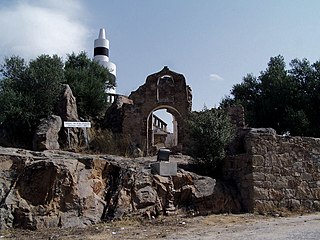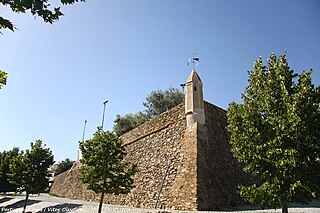Related Research Articles

Alandroal is a municipality in the Portuguese district of Évora located on the eastern frontier with Spain along the right margin of the Guadiana River in the Central Alentejo region. It is located 341 metres (1,119 ft) above sea level, northeast of Évora and southeast of Estremoz. The population in 2011 was 5,843, in an area of 542.68 km2.

The Castle of Carrazeda de Ansiães, normally shortened to Castle of Ansiães, is a medieval castle in the civil parish of Lavandeira, municipality of Carrazeda de Ansiães of Portugal.

The Castle of Alegrete is a Portuguese medieval castle in the civil parish of Alegrete, in the municipality of Portalegre, in the district of the same name.

The Castle of Faria is a castle in the northern Portuguese civil parish of Gilmonde, municipality of Barcelos, in the Cávado.

Castle of Loulé is a castle in the municipality of Loulé, in the Portuguese Algarve. Classified a National Monument, since 20 June 1924, three towers remain within the cordon of walls, the remnants of the town hall located within the structure.

The Castle of Lousã, also known as the Castle of Arouce, is a classified National Monument situated 2 kilometres (1.2 mi) from the civil parish of Lousã e Vilarinho, municipality of Lousã. It was constructed in the second-half of the 11th century, on the right margin of the River Arouce.

The Castle of Moreira de Rei is a well-preserved medieval castle located in the civil parish of Moreira de Rei, in the municipality of Trancoso, Portuguese district of Guarda.

The Castle of Alcanede, is a Portuguese medieval castle in civil parish of Alcanede, in the municipality of Santarém, in the Ribatejo district of Santarém.

The Castle of Alter do Chão is a Portuguese medieval castle in civil parish of Alter do Chão, in the municipality of Alter do Chão, in the district of Portalegre.

The Castle of Arronches, is a Portuguese medieval castle in civil parish of Assunção, in the municipality of Arronches, in the district of Portalegre.

The Castle of Avô is a medieval castle located in the civil parish of Avô, municipality of Oliveira do Hospital, in the Portuguese district of Coimbra.
The Castle of Barbacena is a former-medieval castle/fort in the civil parish of Barbacena e Vila Fernando, municipality of Elvas in the Portuguese Alentejo, classified as a Property of Public Interest.

The Castle of Folgosinho, is a medieval castle in the civil parish of Folgosinho, municipality of the Gouveia in the district of Guarda in the Centre region of Portugal.

The Castle of Vidigueira is a castle in the civil parish of Vidigueira in the municipality of Vidigueira in the Portuguese subregion of Baixo Alentejo. Although constructed in the first half of the 15th century, it is more commonly associated with the first of the Counts of Vidigueira: Vasco da Gama.

The Castle of Mirandela is a medieval castle in the civil parish of Mirandela, municipality of the same name, in the Portuguese district of Bragança.

The Castle of Avis is a Portuguese medieval castle in civil parish of Avis, in the municipality of the same name, in the Alentejo district of Portalegre.

The Castle of Castelo Melhor is a medieval castle located in the civil parish of Castelo Melhor, in the municipality of Vila Nova de Foz Côa, Portuguese Guarda. The castle is one of the best examples of secondary medieval fortresses, erected in one of the more peripheral zones of the peninsular kingdoms.

The Castle of Ródão is a medieval castle located in the civil parish of Vila Velha de Ródão, in the municipality of Vila Velha de Ródão, Portuguese Castelo Branco.

The Castle of Moura is a Portuguese medieval castle in civil parish of Moura e Santo Amador, in the municipality of Moura, in the district of Beja.
References
Notes
- 1 2 3 4 5 6 7 8 9 10 11 12 13 14 15 Perdigão, Lurdes; Matias, Cecília (2002), SIPA (ed.), Castelo de Atouguia da Baleia (IPA.00003338/PT031014020015) (in Portuguese), Lisbon, Portugal: SIPA – Sistema de Informação para o Património Arquitectónico, archived from the original on 20 December 2016, retrieved 3 April 2016
- 1 2 3 4 5 6 Restos da torre e muralhas do antigo Castelo de Atouguia da Baleia, IGESPAR – Instituto de Gestão do Património Arquitectónico e Arqueológico (Portuguese Institute of Architectural and Archaeological Heritage), 2015, retrieved 2 April 2016
- ↑ Calado (2000), p.33-34
Sources
- Leal, Pinho (1873), Portugal Antigo e Moderno (in Portuguese), vol. I
- Grande Enciclopédia Portuguesa e Brasileira (in Portuguese), vol. 3, Lisbon, Portugal
- Sequeira, Gustavo de Matos (1955), Inventário Artístico de Portugal (in Portuguese), vol. V, Lisbon, Portugal
{{citation}}: CS1 maint: location missing publisher (link) - Tesouros Artísticos de Portugal (in Portuguese), Lisbon, Portugal, 1976
{{citation}}: CS1 maint: location missing publisher (link) - À Descoberta de Portugal (in Portuguese), Lisbon, Portugal, 1982
{{citation}}: CS1 maint: location missing publisher (link)


